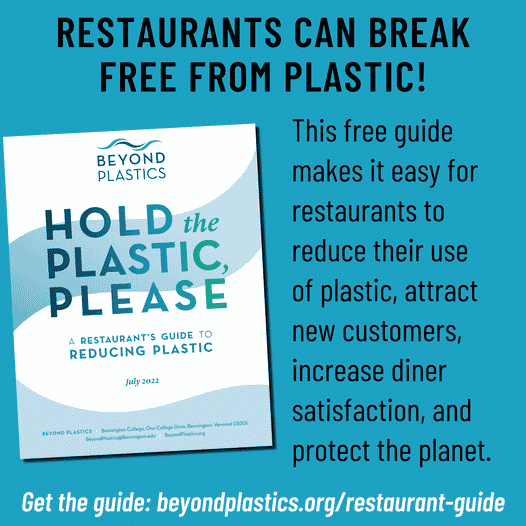PR / USA (July 2022) — After years of pandemic-driven take-out orders, many consumers whose drawers are overflowing with plastic straws, disposable plastic cutlery, and single-use plastic packets of ketchup, soy sauce, and mustard are clamoring for less plastic with their food. Fortunately, a new Plastic Free July guide called “Hold The Plastic, Please – A Restaurant’s Guide To Reducing Plastic” published by Beyond Plastics offers restaurants detailed, practical, and inspiring advice for how to reduce the use of plastic in their operations and how to effectively convey those changes to customers, reporters, and the general public.
The free guide offers practical advice, tools, resources (including funding sources), and case studies, and is available athttps://www.beyondplastics.org/restaurant-guide.
“Industry research has found that the use of plastic makes consumers feel guilty, frustrated, and annoyed – precisely the opposite of what restaurant owners want their customers to experience. The majority of people surveyed also shared that they feel restaurants must do more to address the plastics problem directly,” said Megan Wolff, Ph.D., MPH, lead author of the guide and Beyond Plastics Policy Director.
“Restaurants, in particular, have a big role to play in addressing our plastic pollution crisis. We want to help restaurant owners and managers take the first step towards becoming part of the solution,” said Judith Enck, Beyond Plastics President and former United States Environmental Protection Agency Regional Administrator. “Absent business changes, it is also important for governments to adopt new policies that reduce the use of plastics and propel a shift to reusable and refillable food packaging. Many of those steps, such as not automatically providing a mountain of condiments and napkins and plastic straws with every take-out order, will also save businesses money,” said Enck.
Some numbers and facts to help put the growing plastic pollution crisis into perspective:
The United States generates more plastic waste than any other nation. Plastic litters our streets, beaches, national parks, and communities. Between 9 and 15 million metric tons of plastic pollution enter the ocean each year globally – the equivalent of dumping a garbage truck of plastic into the ocean every minute. Most of this plastic comes from litter that washes into streams and rivers and then flows into the ocean.
Plastics damage our planet and endanger human health at every phase of their lifecycle. The manufacture of plastics involves toxic chemicals including PFAS, phthalates, and heavy metals. Plastics persist in the environment where they can kill seabirds and animals and eventually break down into tiny pieces called microplastics that contaminate the food chain andtravel through our air and water. Even when used under regular conditions, the chemical additives in plastics can leach into food. Tiny fragments of plastics called nanoplastics have been found in all three sides of the human placenta, in breast milk, in the bloodstream, and in lung tissue.
Plastics release toxins when they are burned in incinerators, polluting our air, water, and soil. It’s important to note that plastics manufacturing facilities, incinerators, and landfills are overwhelmingly located in low-income communities and communities of color, jeopardizing the health of residents and posing a major threat to environmental justice.
Plastics are also a major contributor to our growing climate change crisis. As of 2020, the U.S. plastics industry is responsible for at least 232 million tons of CO2e gas emissions per year and is on track to surpass the greenhouse gas emissions of the U.S. coal industry by 2030.
Plastics recycling has been an undeniable failure, achieving an anemic recycling rate of 5-6% in 2021. About 40% of virgin plastic production is used for plastic packaging and about 30% of our waste stream consists of packaging. The obvious solution to this problem is to reduce the creation of plastic packaging and single-use disposables.
Already, many eateries are choosing to either become plastic free, reduce their use of plastic, or eliminate single-use disposable items. In doing so, these restaurants have demonstrated that they can decrease costs, grow their clientele, increase revenue, and make a real and vital contribution to the health of the environment. Their actions send an important message to consumers: the future is not in plastics.
The potential is real, and the benefits to restaurants’ bottom line and customer satisfaction have already been proven. Beyond Plastics urges all restaurants to join the growing movement to reduce the use of plastics and end plastic pollution and offers this free guide to help them make the changes needed to reduce their use of plastics while improving their relationship with customers and the earth, and sometimes even saving money.
You can find the guide at: https://www.beyondplastics.org/restaurant-guide.
###
Related: 6 Innovations That Make Beverage Can Packaging More Sustainable

